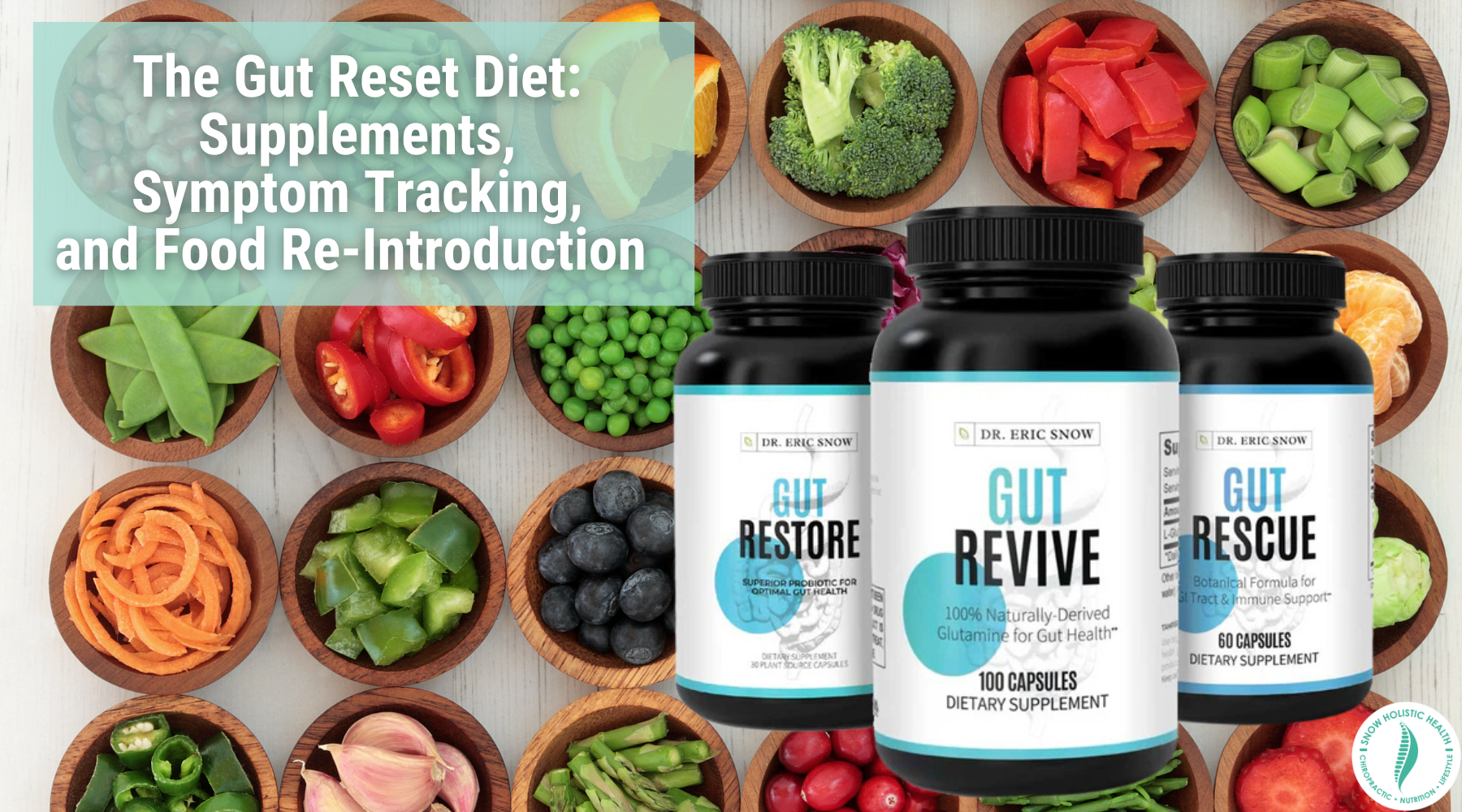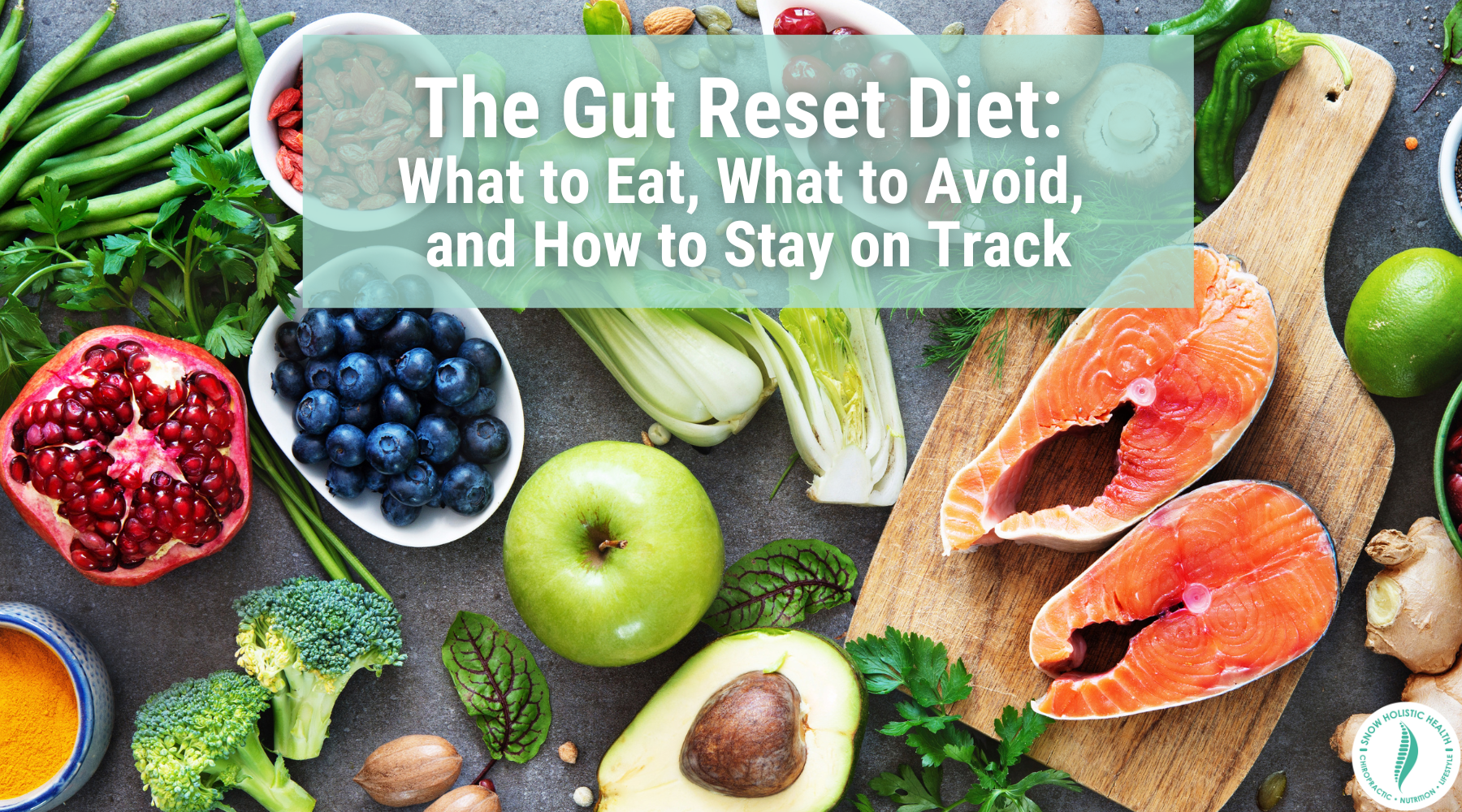The Gut Reset Diet: Supplements, Symptom Tracking, and Food Re-Introduction

Are you struggling with leaky gut and dysbiosis? Are you looking to debloat, soothe chronic inflammation, boost your digestion, and beat brain fog? The Dr. Eric Snow Gut Reset Diet is a proven solution for leaky gut and other common GI tract imbalances caused by chronic inflammation, hidden food intolerances, and various lifestyle factors.
In Part 1 and Part 2 of our Gut Reset Diet series, we covered the science behind the Gut Reset Diet as well as what to eat, what not to eat, and how to stay on track. In Part 3, we’ll explore: how (and why!) to track your symptoms, the importance of food journaling, re-introducing foods, as well as important supplements that can help rebalance the gut’s microbiome. Hint: it’s more than just probiotics!
What is Dr. Eric Snow’s Gut Reset Diet?
Dr. Eric Snow’s Gut Reset Diet isn’t a weight loss diet (although many of my patients have lost weight and improved their overall fitness as a result. The Gut Reset Diet is intended to help reset your gut’s microbiome (the ecosystem of beneficial bacteria, yeasts, fungi, and microorganisms that live in the lower intestine), and reverse the chronic inflammation that leads to leaky gut.
At its core, the Gut Reset Diet is based on the elimination diet protocol, which was developed to identify food intolerances and correct digestive issues like bloating, gas, diarrhea, and constipation.
As discussed in Part 2 The Gut Reset Diet: What to Eat, What to Avoid, and How to Stay on Track, the Gut Reset Diet is a 30-day lifestyle reset that helps you identify and (temporarily) eliminate problematic foods such dairy, eggs, soy, and gluten, while encouraging you to shift your diet toward gut-healthy choices such as lean meats, cooked vegetables, and fermented foods like sauerkraut and kimchi. After the 30-day mark, possible “trigger” foods can be slowly phased back into your diet while monitoring for a return of symptoms.
Why Symptom Tracking and Food Journaling Matter
Like a fingerprint, your intestinal microbiome is unique. This is because the ecosystem that lives inside your lower intestine stems from a combination of factors, including genetics, autoimmune health, toxin exposure, diet, exercise, and other lifestyle choices such as smoking, alcohol consumption, and stress.
As a result, the way your body reacts to different foods will also be unique. In the same way that some people might break out in hives after eating peanuts, or experience severe cramps from carrageenan consumption, the inflammation and bacterial imbalances that lead to dysbiosis are specific to you.
In order to identify what is disrupting your microbiome (and what helps rebalance it), tracking both your symptoms and your food intake is a must during the 30-day Gut Reset Diet.
In the following video, we explore:
- How and why to track dysbiosis symptoms
- The science behind symptom tracking
-
How food journaling can help you stay consistent
Download the Gut Reset Program Weekly Symptom Tracker
Download the Gut Reset Daily Food Journal
Food Re-Introduction
After the elimination period of the 30-Day Gut Reset Diet, it’s time to carefully reintroduce possible “trigger” foods. It’s important to remember: for the program to be effective and last beyond the initial 30 days, re-introduction should focus on carefully monitoring your body for leaky gut flares and symptoms. This is the time to identify which foods are an issue for your body all the time, which are an issue some of the time, and which foods are okay to eat freely.
The Role of Supplements
Finally, an essential part of rebuilding your microbiome is pushing out bad bacteria and yeasts (like Candida albicans) and adding good, probiotic bacteria back in. In addition to probiotic foods like kefir, kombucha, yogurt, and kimchi, probiotic supplements help boost the number of good bacteria living in the gut.
As part of the 30-Day Gut Reset, we highly suggest using the Dr. Eric Snow’s Gut Trio of Supplements. That includes:
Dr. Eric Snow’s Gut Rescue
Gut Rescue targets bad bacteria and yeasts with a high-power combination of four organic antimicrobial herbs: clove, wild bear garlic, olive leaf, and oregano. These antibacterial herbs have been shown to be effective against most non-beneficial gut microbes, especially those that can be difficult to remove due to sticky, protective biofilms. This clears the way for beneficial bacteria and other good gut microbes to come in and repopulate.
Dr. Eric Snow’s Gut Revive
L-glutamine is an essential amino acid and a major fuel source for the cells that line our gut. And that’s not all: glutamine helps maintain protective mucus, support gut lining repair, power immune function, and heal wounds. Specially formulated with 100% natural l-glutamine sourced from beneficial bacteria, Dr. Eric Snow’s Gut Revive is designed to help your gut heal without allergenic additives or fillers.
Dr. Eric Snow’s Gut Restore
Dr. Eric Snow’s Gut Restore contains 18 potent strains of probiotic bacteria, including eleven different strains of Lactobacillus. Ideal for supporting a range of health concerns including poor digestion, mental health and cognition, immune system function, and even weight management, Dr. Eric Snow’s Gut Restore can help overhaul a struggling microbiome. But the real star of the show is Gut Restore’s “secret ingredient”: DE111. DE111 is a research-backed, spore-forming strain of probiotic bacteria that can withstand the extreme temperature and pH of the small intestine for increased proliferation.
For increased effectiveness, pair Dr. Eric Snow’s Gut Trio with the Gut Trio Supplement Schedule:



